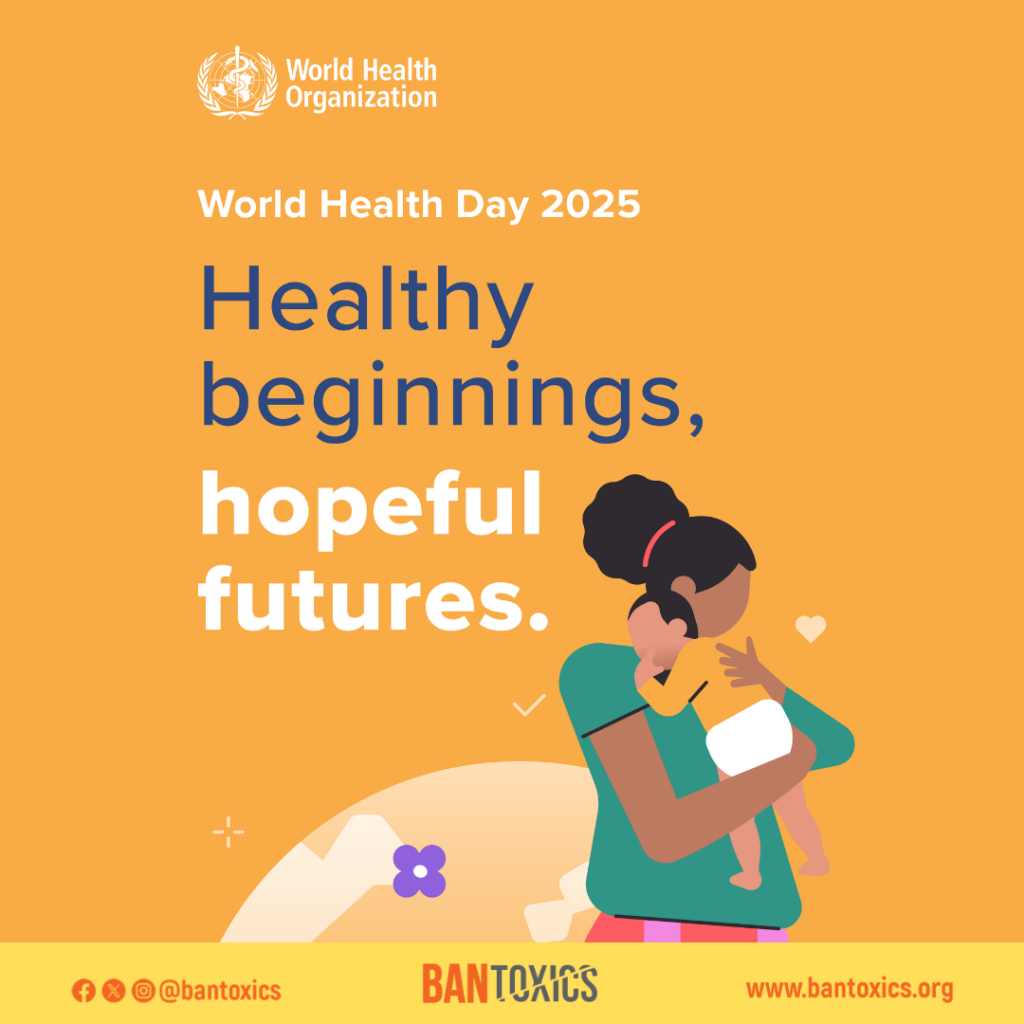
BAN Toxics joins the global community in celebrating World Health Day, supporting the World Health Organization’s (WHO) campaign, ‘Healthy Beginnings, Hopeful Futures,’ which calls on governments and the health sector to intensify efforts to end preventable maternal and newborn deaths and to prioritize the long-term health and well-being of women.
According to the WHO’s latest estimates, nearly 300,000 women die each year from pregnancy- or childbirth-related complications. More than 2 million babies die within their first month of life, and approximately 2 million more are stillborn.
The WHO further reports that, based on current trends, four out of five countries are not on track to meet the targets for improving maternal survival by 2030. Additionally, one in three countries is expected to fall short of the goals for reducing newborn deaths. According to the Philippine Statistics Authority, there were a total of 1,868 recorded maternal deaths in the country in 2023.
As an environmental justice organization advocating for the sound management of toxic chemicals and waste, BAN Toxics emphasizes the urgent need to protect women and children from exposure to toxicants and pollutants commonly found in our daily environments.
The following are some of the most concerning environmental chemicals affecting women’s health.
Mercury
Mercury is recognized by the WHO as one of the top ten chemicals of major public health concern due to its toxic effects on the nervous, immune, and digestive systems, as well as the lungs, kidneys, skin, and eyes. Even low-level exposure can pose serious health risks, especially to pregnant women and young children.
Mercury occurs naturally in the environment but is also released through human activities such as coal and oil burning, mining, and the use of certain products like fluorescent bulbs and thermometers. Once released, it persists in ecosystems, builds up in the food chain, and can accumulate in the human body, leading to long-term health risks.
A growing and alarming source of mercury exposure is its widespread use in skin-lightening products, which often contain mercury and are illegally sold in many markets. Long-term use of these products puts women at greater risk of mercury toxicity, often without their knowledge.
Women and children are especially vulnerable, Mercury can pass from a mother to her baby through the placenta during pregnancy and, in smaller amounts, through breast milk after birth. Early exposure can result in birth defects, reduced intelligence, memory and learning problems, and motor skill impairments.
Lead
Lead, like mercury, is a naturally occurring heavy metal and is also classified by the WHO as one of the top ten chemicals of major public health concern. Its widespread use has led to extensive environmental contamination, human exposure, and significant global public health issues.
The most common sources of lead contamination are industrial activities such as mining, smelting, manufacturing, and recycling. Lead is also found in a wide range of products, including pigments, paints, solder, stained glass, crystal glassware, ammunition, ceramic glazes, jewelry, toys, some traditional cosmetics, and certain traditional medicines.
Lead exposure affects multiple body systems and is especially harmful to young children and women of childbearing age.
High levels of lead can cause severe damage to the brain and central nervous system, leading to coma, convulsions, and even death. Children who survive severe lead poisoning may suffer from permanent intellectual disabilities and behavioral disorders.
In women, lead exposure can impair reproductive health, leading to reduced fertility, miscarriage, stillbirth, or birth defects.
Endocrine-Disrupting Chemicals (EDCs)
EDCs are emerging chemicals of concern, as research shows they can interfere with the endocrine system, disrupting hormone activity. This poses risks to fertility, reproductive health, birth outcomes, and increases the likelihood of cancer and skin irritation.
Major sources of EDC pollutants include Bisphenol A, phthalates, parabens, PFAS (Per- and Polyfluoroalkyl Substances), triclosan, and polychlorinated biphenyls, commonly found in the pharmaceutical, cosmetic, and packaging industries.
Studies have shown that women are often exposed to higher levels of non-persistent EDCs, such as parabens, phenols, and phthalates, compared to men, likely due to their greater use of personal care products.
EDCs significantly affect women’s reproductive health, contributing to issues such as delayed puberty, early onset of breast cancer, infertility, irregular menstrual cycles, uterine fibroids, difficulty conceiving, and complications during childbirth.
Unintentional Persistent Organic Pollutants (UPOPs)
UPOPs are toxic chemicals released as by-products of combustion processes involving organic matter and chlorine, or generated during the manufacture of other chemicals, the most common of which are dioxins and furans.
Dioxins and furans are highly toxic chemicals that can have severe health effects, especially on women. Prolonged exposure to these pollutants has been linked to reproductive health issues, including hormonal disruptions, infertility, and complications during pregnancy. They are also associated with an increased risk of breast cancer and other hormone-related cancers. In addition, dioxins and furans can impair immune function, increase the risk of skin disorders, and contribute to developmental problems in children exposed in utero or during early life
Burning of waste is a major source of dioxins and furans, and in a country like the Philippines, where women make up the majority of the informal waste sector, this puts them at heightened risk from toxic emissions. Additionally, improper disposal of healthcare waste, which often contains chlorine-based disinfectants, contributes further to the formation of dioxins and furans when incinerated.
_____
Addressing the harmful effects of these toxic chemicals is crucial for protecting the health and well-being of women and children. It is imperative that governments, industries, and communities work together to reduce exposure to these dangerous substances and pave the way for healthier beginnings and a hopeful future for all.
References:
https://www.who.int/campaigns/world-health-day/2025#:~:text=World%20Health%20Day%2C%20celebrated%20on,on%20maternal%20and%20newborn%20health.
https://psa.gov.ph/statistics/vital-statistics/node/1684066658
https://www.who.int/news-room/fact-sheets/detail/mercury-and-health
https://www.cdc.gov/breastfeeding-special-circumstances/hcp/exposures/mercury.html#:~:text=Mercury%20can%20pass%20from%20a%20mother%20to,problems%20with%20gross%20and%20fine%20motor%20skills.
https://www.sciencedirect.com/science/article/abs/pii/S0013935123021898
https://www.cdc.gov/niosh/reproductive-health/prevention/lead-metals.html
https://www.who.int/news-room/fact-sheets/detail/lead-poisoning-and-health
https://www.sciencedirect.com/science/article/abs/pii/S0025326X24000092#:~:text=Dioxins%20and%20furans%20(PCDD%2FFs,which%20negatively%20affects%20fetal%20growth.
https://www.unep.org/topics/chemicals-and-pollution-action/pollution-and-health/persistent-organic-pollutants-pops/upops


